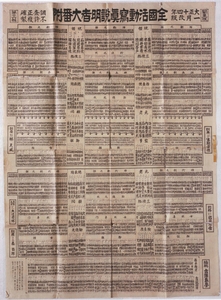This website was developed by Sarah Bither '13 and Melissa Yang '14, DHi 2011-2012 CLASS Scholars.
The Industry, the Stage, and Social Reception
When the Japanese went to the movies, they often chose to go not based on what movie was playing but by what benshi was providing the setsumei. The benshi was the main attraction. Frequently on movie posters, his name appeared larger than even the title of the film. His salary was equivalent to, if not more than, an actor’s, for as an avid fan pointed out, “it is the setsumeisha who cements the connection between the film and the audience. He is the one who brings the film to life and unites the audience with the film. Thus, he should be paid more than actors, who are merely filmed and projected on to the screen…An actor is merely a very tiny element in a motion picture show; at best, an element like the wind, clouds, and trees” (Dym 94). Benshi also had photos taken of them wearing formal wear in imitation of famous politicians and businessmen in order to enhance the image of their authoritative celebrity status.
Consequently, the fates of cinemas were often closely tied to the success of the benshi they employed. A particular benshi’s popularity could be measured based on his banzuke ranking. The banzuke chart was structured after the traditional Sumo wrestling ranking charts. They ranked benshi locally or nationally. A higher banzuke rank meant higher bargaining power with the theater managers. Higher-ranking benshi held more control over what films the theater they worked at showed and what salary they received.Their influence in the theater also extended over the live orchestra that accompanied the film and corresponding setsumei. The live music was meant to intensify the audience’s emotional response and also to draw out the length of the film. The benshi’s seat of power in the theater gave him authority to dictate how the music was to be played, controlling elements such as breaks and tempo, so it would best harmonize with the setsumei. The orchestra should not outperform or overpower the benshi, since in the theater, at least from a benshi’s standpoint, “setsumei is the lord, music is the retainer” (Dym 60). A popular benshi held a great deal of influence over the management of the cinema.
Movie producers, too, were subordinate to the poets of the dark. They relied on the performers to smooth over any poor editing or a terribly written script. Sometimes, in order to churn out more films quickly, producers spliced scenes from different movies together. The benshi was expected to resolve continuity errors and plot gaps by means of their setsumei. The benshi regarded their narrative skill so highly that often they dictated to directors exactly what type of movie to produce in order to showcase the best of their setsumei. They were also able to edit the films and adjust the films’ speed to better suit the needs of their setsumei. Since projectors were hand-cranked until 1921, a benshi could communicate with the projectionist through a series of codes to indicate how he wanted the projectionist to manipulate the film’s speed. The projectionist slowed down the film when a benshi wanted to show off his well-developed narration and sped up the film when he had nothing to say (Dym 55). Naturally, many filmmakers were upset with the benshi’s physical manipulation of the film and their interpretative control over the film’s content, but this mattered little so long as the audience continued to revere and support their favorite benshi.
Not all members of the Japanese audience, however, held the benshi in awe. Articles written about the private lives of the benshi were rare. A large gap existed between their lives on the stage and off it. The lack of journalism emphasized that although the benshi were adored as stars, they were not regarded as role models for anyone other than their disciples. This was in part due to many people’s disgust at the benshi’s hedonistic lifestyle. The benshi symbolized the new Taisho liberalism, which some saw as equivalent to alcoholic and sexual deviancy. Not all benshi lived this way, of course, but many did turn to such a life of pleasure that eased the mental strain and nervous breakdowns caused by their exhausting profession. Harsh critics cast the benshi as low as rickshaw pullers. The one redeeming quality they held of the benshi was that if a person truly desired to enter the lowly profession of entertainment, a benshi was optimal for at least setsumei was given in the dark and one’s face could not be seen. Such were the flawed sentiments of Tokugawa Musei’s own father, failing to realize that maesetsu was given on a lit stage and that the benshi’s rising popularity would only push them further into the spotlight (Dym 100).
Despite this criticism, however, benshi were still wildly popular. There was limited development of film technique, little use of editing or subtitling, and no stage play as audiences continued to go to the movies for the sake of the benshi and not the craft of the film. New techniques, such as dramatic lighting and close-ups, continued to filter in from abroad, but Japanese feelings of superiority labeled these techniques and films as distinctly “American-style” or “foreign.” Only films narrated by a benshi were pure Japanese-style and truly for the Japanese. The benshi became symbols of national pride.



